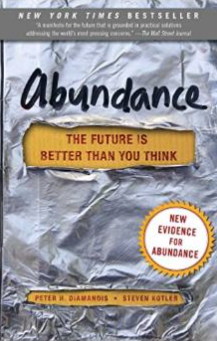I recently read “Abundance: The Future Is Better Than You Think” by Peter H. Diamandis and Steven Kotler. Below are the quotes I found most interesting. If you like the quotes, click here to buy the book.
 “Many of today’s dangers are probabilistic – the economy might nose-dive, there could be a terrorist attack – and the amygdala can’t tell the difference. Worse, the system is also designed not to shut off until the potential danger has vanished completely, but probabilistic dangers never vanish completely. Add in an impossible-to-avoid media continuously scaring us in an attempt to capture market share, and you have a brain convinced that it’s living in a stage of siege.” (33)
“Many of today’s dangers are probabilistic – the economy might nose-dive, there could be a terrorist attack – and the amygdala can’t tell the difference. Worse, the system is also designed not to shut off until the potential danger has vanished completely, but probabilistic dangers never vanish completely. Add in an impossible-to-avoid media continuously scaring us in an attempt to capture market share, and you have a brain convinced that it’s living in a stage of siege.” (33)
“A week’s worth of the New York Times contains more information than the average seventeenth-century citizen encountered in a lifetime.” (34)
“Exponential growth is just a simple doubling: 1 becomes 2, 2 becomes 4, 4 becomes 8, but, because most exponential curves start out well below 1, early growth is almost always imperceptible. When you double .0001 to .0002 to .0004 to .0008, on a graph all these plot points look like zero. In fact, at this rate, the curve stays below 1 for a total of thirteen doublings. To most people, it just looks like a horizontal line. But only seven doublings later, that same line has skyrocketed above 100. And it’s this kind of explosion, from meager to massive and nearly overnight, that makes exponential growth so powerful. But with our local and linear brains, it’s also why such growth can be so shocking.” (53)
“Because the quality of our tools has finally caught up to the scope of their vision – small groups of dedicated DIY innovators can now tackle problems that were once solely the purview of big governments and large corporations.” (122)
“By nature, entrepreneurs aren’t satisfied until they do change the world, and let nothing get in their way.” (135)
“There are four major motivators that drive innovation: curiosity, fear, the desire to create wealth, and the desire for significance… One tool that harnesses all four of these motivators is called the incentive prize.” (218)
“With no bureaucracy, little to lose, and a passion to prove themselves, small teams consistently outperform larger organizations when it comes to innovation.” (223)
“In a world without constraints, most people take their time on projects, assume fewer risks, spend money wastefully, and try to reach their goals in comfortable and traditional ways – which, of course, leads nowhere new.” (225)
“Incentive prizes are not a panacea; they can’t fix all that ails us. But on the road toward abundance, when a key technology is missing, or a specific end goal has been identified but not yet achieved, incentive prizes can be an efficient and highly leveraged way to get from A to B.” (226)
“As Burt Rutan puts it, “Revolutionary ideas come from nonsense. If an idea is truly a breakthrough, then the day before it was discovered, it must have been considered crazy or nonsense or both – otherwise it wouldn’t be a breakthrough.”” (229)
“Arianna Huffington says, “You’ll never be able to achieve big-time success without risking big-time failure. If you want to succeed big, there is no substitute for simply sticking your neck out. Of course, nobody likes to fail, but when the fear of failure translates into taking fewer risks and not reaching for our dreams, it often means never moving ahead. Fearlessness is like a muscle: the more we use it, the stronger it becomes. The more we are willing to risk failure and act on our dreams and our desires, the more fearless we become and the easier it is the next time. Bottom line, taking risks is an indispensable part of any creative act.” (230)
“If your goal is to reshape the world, then how the world learns about your plan is every bit as important as the plan itself.” (231)
“Each of us has an internal ‘line of credibility.’ When we hear of an idea that is introduced below this line, we dismiss it out of hand. If the teenager next door declares his intent to fly to Mars, you smirk and move on. We also have an internal line of supercredibility. Should it be announced that Jeff Bezos, Elon Musk, and Larry Page have committed to fund a private mission to Mars, “When is it going to land?” becomes a much more reasonable question. When we hear an idea presented above the supercredible line, we immediately give it credence and use it to anchor future actions.” (231)
“A powerful first impression (in other words, announcing your idea in a supercredible way) is fundamental to launching a breakthrough concept. But I also saw the importance of mind-set. My mind-set. Sure, I had wanted to open up space since my childhood, but was I really sure this approach would work? In getting to supercredibility, I had to lay out my ideas before the aerospace industry’s best and brightest, testing my premises and answering uncomfortable questions. in doing so, whatever doubts I’d had vanished along the way. By the time I was on stage with my dignitaries, the idea that the X PRIZE could work wasn’t a hopeful fantasy, it was the tomorrow I was certain would soon arrive. This is the second thing I learned that day: the awesome power of the right mind-set.” (232)
“Before the average American earns $75,000 a year, there is a direct correlation between money and happiness. Above that number, the correlation disappears.” (237)
Liked the quotes? Get the book here

